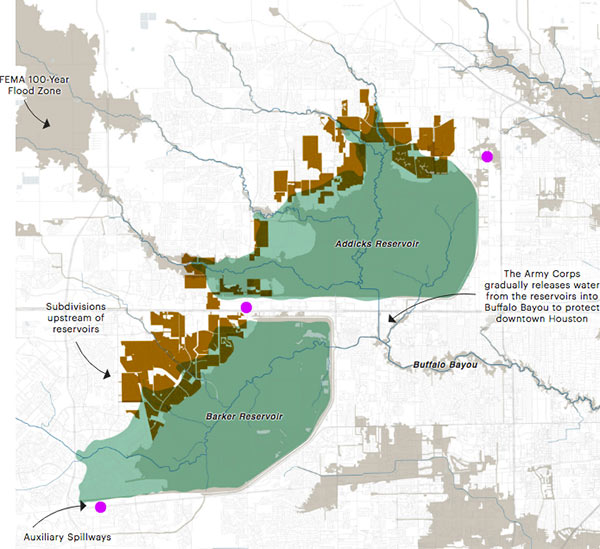STUFF YOU PROBABLY SHOULD KNOW ABOUT THE ADDICKS AND BARKER RESERVOIRS  Lived in Houston for years but still coming up to speed on how the Addicks and Barker dams are supposed to work — just as the reservoirs reach to their highest-ever levels? This brief explainer from Kiah Collier and Neena Satija of The Texas Tribune Al Shaw and Lisa Song of ProPublica should overfill you with info: “As of now, the Army Corps says there’s enough excess water in the reservoirs that some of it will flow around (not overtop) these auxiliary spillways. . . . The Army Corps can’t say exactly what areas might experience additional flooding, but local officials listed 53 subdivisions in the Addicks watershed and 40 in the Barker watershed (shown in brown in the map above) at high risk of flooding. Jeremy Justice, a hydrologic analyst at the Harris County Flood Control District, said two subdivisions near the Addicks reservoir—Twin Lakes and Lakes On Eldridge—are particularly vulnerable to flooding from the Addicks spillway. Those homes ‘probably should never have been put there,‘ he said.” Thousands of homes around the reservoirs have now flooded — some because they’re close to rising bayous, and some because of bad neighborhood drainage, they write. “But many are flooding because they are in an area that the Army Corps actually considers to be inside the reservoirs. (See map.)” [Texas Tribune; ProPublica version with links; previously on Swamplot] Map: ProPublica
Lived in Houston for years but still coming up to speed on how the Addicks and Barker dams are supposed to work — just as the reservoirs reach to their highest-ever levels? This brief explainer from Kiah Collier and Neena Satija of The Texas Tribune Al Shaw and Lisa Song of ProPublica should overfill you with info: “As of now, the Army Corps says there’s enough excess water in the reservoirs that some of it will flow around (not overtop) these auxiliary spillways. . . . The Army Corps can’t say exactly what areas might experience additional flooding, but local officials listed 53 subdivisions in the Addicks watershed and 40 in the Barker watershed (shown in brown in the map above) at high risk of flooding. Jeremy Justice, a hydrologic analyst at the Harris County Flood Control District, said two subdivisions near the Addicks reservoir—Twin Lakes and Lakes On Eldridge—are particularly vulnerable to flooding from the Addicks spillway. Those homes ‘probably should never have been put there,‘ he said.” Thousands of homes around the reservoirs have now flooded — some because they’re close to rising bayous, and some because of bad neighborhood drainage, they write. “But many are flooding because they are in an area that the Army Corps actually considers to be inside the reservoirs. (See map.)” [Texas Tribune; ProPublica version with links; previously on Swamplot] Map: ProPublica





The Texas Tribune and ProPublica articles are a joke and emblematic of “hot take” journalism. No explanation of how the reservoirs were intended to operated is listed.
The elevations the homes were built at are set by USACE under normal operational conditions. Local regulators used guidelines from USACE modeling to allow upstream development. It wasn’t just a random irresponsible government.
The reservoirs are never intended to get to the elevations they are currently experiencing. The reservoirs have a good 10 feet of freeboard to maintain structural integrity under the design storms. The operational procedures of the reservoirs set that no water should be released from them while it is raining. This allows the downstream portions of Buffalo Bayou to return to near norm elevations in anticipation of releases. When raining ceases, release of flows begin. Both reservoirs are set to release about 4000 cfs each until upstream water surface elevations normalize. Downstream on Buffalo Bayou, these releases are low enough to not create problems (other than fast moving water).
No one should take the rainfall amount we received to judge our flood control infrastructure. There will never be measures constructed to handle what we received. You can do all the low impact development and channel work and achieve nothing to prevent what we’ve seen over the last few days.
The USACE were faced with the tough decision to release water while downstream conditions were still high. This is not a decision made quickly either. Houston, Harris County, the Memorial villages, and HCFCD were all notified. Ultimately, a controlled release is always preferable than an uncontrollable breach.
All the watersheds operated as expected under these extreme rainfall amounts.
I read these articles yesterday and was disgusted by them with the lack of information presented. All I can do is laugh. Luckily these idiots writing these articles will not direct policy going forward.
The events today will be modeled and study thoroughly. Billions will be spent in recovery. Due to the frequent flooding events, large areas of Houston will likely not be allowed to rebuilds with flood insurance money. Many of these homes will be candidates for buyout. Large collections of buyouts present chances to construct regional detention systems. The new system will still not be enough to offset the size of the events we just experienced.
How in the world did the government allow the developers to build houses in Twin Lakes, Lakes of Eldridge, and all the other subdivisions that have catastrophic flooding from Addicks? They had to know.
It might still be early, but I am ready to talk about the short and long term real estate impacts of these floods.
As much as we want to blame developers, the greed from the politicians and the local governments are as much to blame. The $ signs in everyones eyes blinded them to the bad development plans and the lack of prudent engineering design for stormwater. I agree with KJB434, we are so far beyond a normal event here that blame for much of this cannot be placed on anyone. But this is certainly not the first reference to things that clearly should not have been built in places we clearly knew were a danger. But builders built because the city let them because all they saw were the additional addresses on the tax rolls.
The double whammy is about to hit the city though. Thousands (tens of even) addresses that are going to lose significant value as a result of Harvey and a proletariat that demands remedy that is going to cost serious money.
I was blessed, my house came out fine. The next disaster I am keeping an eye on is 2018 taxes. When HCAD decides that because my house was flood free it is now worth twice as much.
kjb434, one must also acknowledge that the reservoirs, built 50+ years ago for a 1/500 type rainfall, were not designed for the population we now have. Thus, we should ask, do the models properly model the demand on the regional wide infrastructure? By reducing the amount of available prairie lands (think of as a buffer to flooding) for natural absorption of rain water, we are forcing run off to our existing reservoirs, lakes, bayous (which the capacity of both Buffalo and Brays have increased over the last 10 years) and rivers. This creates a huge burden on the overall drainage system. Lastly, in general, it does not seem to be a good idea to build into a reservoir or onto a river, whether Brazos, San Jac or Dickinson bayou. We have now had 3 1/500 rain falls in just over 2 years. From a govt insurance point of view, we need to re-evaluate our risk when building into floodplains.
kjb434,
I’m afraid that your confusing post is filled with misinformation. Particularly this:
“Both reservoirs are set to release about 4000 cfs each until upstream water surface elevations normalize. Downstream on Buffalo Bayou, these releases are low enough to not create problems (other than fast moving water).”
On Aug. 29 the Harris County Flood Control District announced that the Corps would be releasing a combined flow of 13,000 cubic feet per second (cfs) from both reservoirs.
https://www.hcfcd.org/press-room/current-news/2017/08/controlled-releases-on-addicks-and-barker-reservoir-increase-flooding-threat-along-buffalo-bayou/
Any flow above 4,000 cfs is enough to flood property downstream. The flow in Buffalo Bayou as measured by the Piney Point gauge, which is the gauge the Corps uses to monitor the impact on the bayou, has been over 10,000 cfs and as high as nearly 18,000 cfs since Aug. 27.
https://waterdata.usgs.gov/usa/nwis/uv?site_no=08073700
Numerous homes below the dams have been flooded during this time.
Never heard of these USACE regulations or guidelines for elevations of homes built in the floodway or floodplain or for development upstream of the reservoirs. Could you share that with us? Also, who are these “local regulators” to whom you refer?